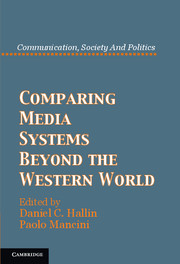9 - The Rise of Transnational Media Systems
Implications of Pan-Arab Media for Comparative Research
from Part II - Methods and Approaches
Published online by Cambridge University Press: 05 June 2012
Summary
The nation-state as unit of analysis underpins the three models of media and politics Hallin and Mancini develop in Comparing Media Systems (2004b). Although they “take the nation-state as [our] primary unit of analysis…and media systems have to a large extent been organized at this level over the past couple of centuries,” the authors recognize that “it is important to keep in mind that this in some ways misleading” (Hallin and Mancini, 2004b: 71). Livingstone similarly argued that “the nation is itself not a proper unit of comparison” and that “any project seeking to conduct cross-national comparisons must surely argue the case for treating the nation as a unit, rather than simply presuming the legitimacy of such a research strategy” (Livingstone, 2003: 479–80). This chapter explores one world region in which the primacy of the nation-state as an analytical category may indeed be misleading; through analyzing the rise of pan-Arab media as a transnational system, I raise questions about the universal applicability of the nation-state and provide significant fodder to Hallin's statement that “media systems do not necessarily coincide neatly with nation-state boundaries” (Hallin, 2009: 101).
Since 1990, Arab national broadcasting systems focused on development, propaganda, and national unity have been overshadowed by a pan-Arab satellite television industry whose ownership and agendas converge and compete with nation-state policies. This development encompasses twenty-two nation-states located in one of the world's intractable geopolitical flashpoints. Contemporary Arab media consist of an unevenly integrated regional (pan-Arab) market, superimposed onto national systems and increasingly integrated into the global media market, although in many respects distinct from both: It is a transnational media system.
- Type
- Chapter
- Information
- Comparing Media Systems Beyond the Western World , pp. 177 - 200Publisher: Cambridge University PressPrint publication year: 2011
- 8
- Cited by

